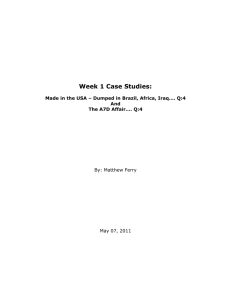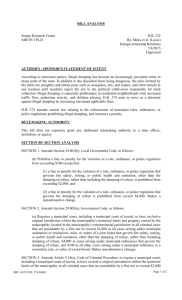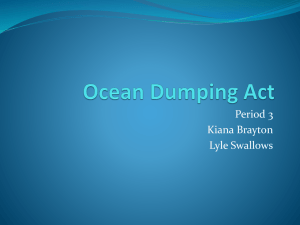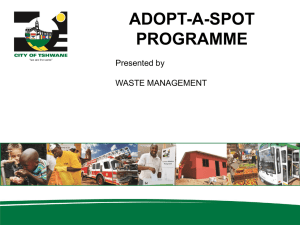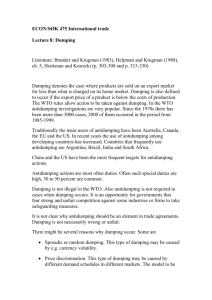Sea Dumping Permit Application Fees
advertisement
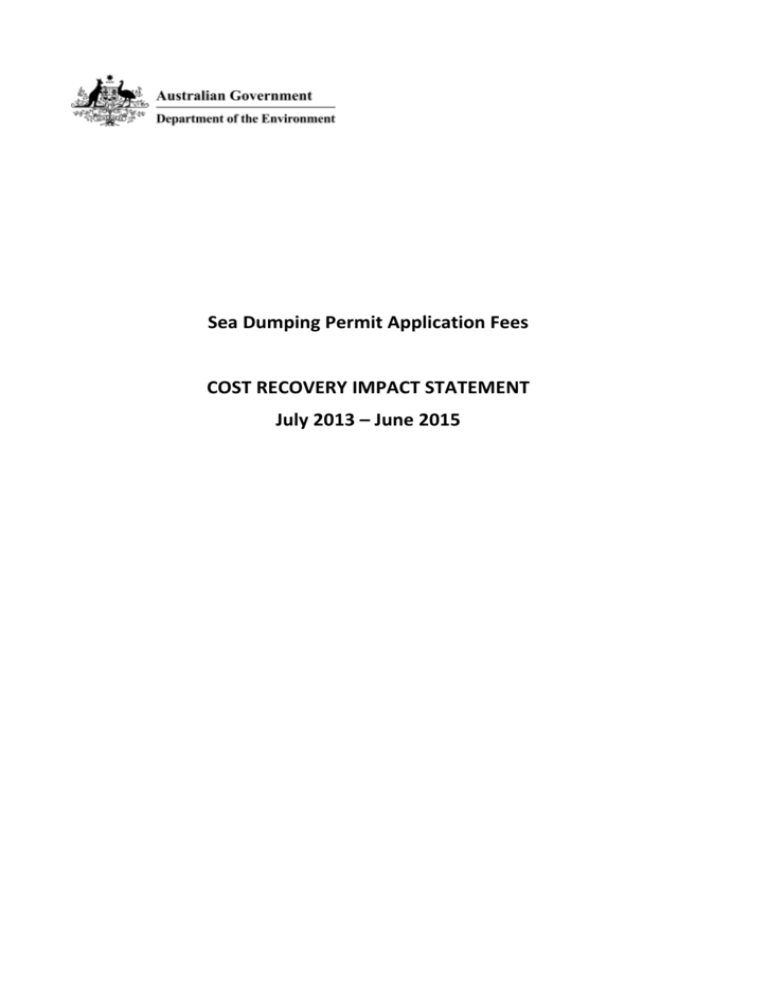
Sea Dumping Permit Application Fees COST RECOVERY IMPACT STATEMENT July 2013 – June 2015 2013-2015 CRIS for Sea Dumping Permit Application Fees Table of Contents 1. OVERVIEW 1.1 1.2 1.3 2. POLICY REVIEW – Analysis of Activities 2.1 2.2 2.3 2.4 2.5 2.6 3. Projected Expenses and Revenue MONITORING MECHANISMS 6.1 6.2 6.3 7. Cost Recovery Activities Costs Components Changes in Cost Base Volume and Demand Assumptions Summary of Charging Arrangements PROJECTED EXPENSES AND REVENUE FOR THE CRIS 5.1 6. Design of the Cost Recovery Arrangement Basis of Charging – Fee or Levy COST RECOVERY MODEL 4.1 4.2 4.3 4.4 4.5 5. Policy Authority Partial cost recovery Legal Requirements for the Imposition of Charges Description of Cost Recovery Activities Users and Stakeholders Conclusion DESIGN 3.1 3.1 4. Purpose Background Australian Government Cost Recovery Policy Monitoring Mechanisms Stakeholder Consultation Periodic Review CERTIFICATION Page 2 of 13 2013-2015 CRIS for Sea Dumping Permit Application Fees 1. OVERVIEW 1.1 Purpose The purpose of this Cost Recovery Impact Statement (CRIS) is to document cost recovery arrangements for the Sea Dumping Permit application fees and demonstrate their compliance with the Australian Government Cost Recovery Guidelines. The Department of the Environment (the Department) plans to review these cost recovery arrangements prior to the expiry of the current CRIS in 2015. 1.2 Background Sea Dumping Permit application fees are authorised under the Environment Protection (Sea Dumping) Act 1981 (the Sea Dumping Act) and the Environment Protection (Sea Dumping) Regulations 1983 (the Sea Dumping Regulations). The fees that will apply for the duration of this CRIS remain unchanged since they were approved in 2009. The Department is responsible for the implementation and administration of the Sea Dumping Act through a permitting regime. Permits are required for all sea dumping activities, including dumping dredge spoil; artificial reefs; vessel disposal; offshore platforms; and burials at sea. The prescribed fees vary according to the type of material being dumped and in the case of dredge spoil are categorised based on the quantity of material included in the permit sought. 1.3 Australian Government Cost Recovery Policy In December 2002, the Australian Government adopted a formal cost recovery policy to improve the consistency, transparency and accountability of its cost recovery arrangements and promote the efficient allocation of resources. The underlying principle of the policy is that agencies set charges to recover all the costs of a product or service where it is efficient and effective to do so, where the beneficiaries are a narrow and identifiable group and where charging is consistent with Australian Government policy objectives. The Cost Recovery Policy is administered by the Department of Finance and is detailed in the Australian Government Cost Recovery Guidelines (the Cost Recovery Guidelines). The policy applies to all Financial Management and Accountability Act 1997 (FMA Act) agencies and to relevant Commonwealth Authorities and Companies Act 1997 (CAC Act) bodies that have been notified. In line with the policy, individual portfolio ministers are ultimately responsible for ensuring agencies’ implementation and compliance with the Cost Recovery Guidelines. The Australian Government Cost Recovery Guidelines and the accompanying Finance Circular can be found at: http://www.finance.gov.au/financial-framework/financialmanagement-policy-guidance/cost-recovery.html Page 3 of 13 2013-2015 CRIS for Sea Dumping Permit Application Fees 2. POLICY REVIEW - ANALYSIS OF ACTIVITIES 2.1 Policy Authority to Cost Recover As part of the 2006-07 Budget, the Government initially agreed that fees under the Sea Dumping Act will be imposed on a full cost recovery basis.1 However, following the review of cost recovery arrangements for the Environment portfolio completed in 2011, the Department sought (and obtained) Government’s approval for partial cost recovery arrangements for the Sea Dumping Permits application fees. Until the next review of the cost recovery arrangements is undertaken (section 1.1 refers), partial cost recovery arrangements are considered appropriate to avoid providing a perverse incentive to by-pass the regulations and encourage illegal sea dumping if full costs were recovered. 2.2 Legal Requirements for the Imposition of Charges The authority to charge fees is under the Environment Protection (Sea Dumping) Act 1981 and the Environment Protection (Sea Dumping) Regulations 1983. The Sea Dumping Permit applications for dredging activities are supported by the National Assessment Guidelines for Dredging that are available at http://environment.gov.au/coasts/pollution/dumping/publications/guidelines.html They were last reviewed in 2008-09. The guidelines for other permit applications are http://www.environment.gov.au/coasts/pollution/dumping/index.html 2.3 available at Description of Activities The Sea Dumping Act requires permits to be issued for various activities. It enables Australia to comply with its obligations under the London Protocol to prevent marine pollution caused by dumping or incineration at sea of wastes or other matter (article 3.2 of the London Protocol obliges parties to adopt a polluter pays principle). Activities undertaken by the Department comprise registration, assessment and administration of the Sea Dumping Permit applications. Table 1 in section 4.1 splits Sea Dumping Permit applications into two categories: 2.5 - dredging permit applications and variations, and - burials at sea, artificial reefs, and disposal of platforms and vessels. Users and Stakeholders The Department has ongoing consultative arrangements with Ports Australia, the peak industry body, the relevant State Government agencies and individual applicants where 1 Please refer to the 2006-07 Budget Paper 2 Part 1 page 12 - Budget Paper No. 2: Budget Measures 2006-07 — Contents and Download Page 4 of 13 2013-2015 CRIS for Sea Dumping Permit Application Fees the stakeholder constituency is either known or identifiable and is primarily concerned with dredging and disposal activities. Page 5 of 13 2013-2015 CRIS for Sea Dumping Permit Application Fees 3. DESIGN 3.1 Design of Cost Recovery Arrangement The cost recovery arrangement was designed to reflect the cost of administering the permit process. Dredge Permit application fees relate to the type of material being dumped and, in the case of dredge material, are categorised based on the quantity of the material. This requires detailed analysis of the material to be dredged to determine contaminant levels (if any). Larger volumes may have greater environmental impacts and require more assessment, while applications for small volumes have declined to zero. 3.2 Basis of Charging – Fee or Levy The cost recovery arrangement is a graduated fee structure. Port operators account for the majority of Sea Dumping Permit applications. Fees are considered to be the most appropriate charging mechanisms (i.e. as opposed to an industry levy) due to the ability to clearly identify the entity that requests the service and allocate costs to that service. The fee was set through a consultative process with stakeholders to create a balance between cost recovery and a perverse incentive to by-pass the regulations and encourage illegal sea dumping if full costs were recovered. It is proposed to develop a revised consultative process using the Office of Best Practice Regulation guidelines for regulatory impact assessments. Page 6 of 13 2013-2015 CRIS for Sea Dumping Permit Application Fees 4. COST RECOVERY MODEL 4.1 Cost Recovery Activities Table 1: List of Cost Recovery Activities and associated Charges Ref Activity Name Description Charge Title 1.1 Sea Dumping Permit – Dredged or excavated material greater than 100,000 m3 Sea Dumping Permit – Dredged or excavated material less than 100,000 m3 Variation of Permit Expenses associated with the processing of an application. Application Fee Expenses associated with the processing of an application. Application Fee Expenses associated with the processing of a variation to an existing permit. Expenses associated with the processing of an application. Expenses associated with the processing of an application. Expenses associated with the processing of an application. Expenses associated with the processing of an application. Application Fee 1.2 1.3 2.1 2.2 2.3 2.4 4.2 Sea Dumping Permit – Artificial Reef Sea Dumping Permit – Burial at Sea Sea Dumping Permit Platforms Sea Dumping Permit – Vessels Application Fee Application Fee Application Fee Application Fee Cost Components Table 2: Activity Expenses Activity 1.1 : Processing Costs of a Sea Dumping Permit Application – Dredged or excavated material greater than 100,000 m3 Cost Components Direct - Salaries/On costs Variable Costs - Professional Services Total Activity Cost per Year Jul13 – Jun14 ($’000) Jul14 – Jun15 ($’000) Total ($’000) 52.54 52.54 105.08 89.14 141.68 89.14 141.68 178.28 283.36 Activity 1.2 : Processing Costs of a Sea Dumping Permit Application – Dredged or excavated material less than 100,000 m3 Cost Components Direct - Salaries/On costs Variable Costs - Professional Services Total Activity Cost per Year Jul13 – Jun14 ($’000) Jul14 – Jun15 ($’000) Total ($’000) 0 0 0 0 0 0 0 0 0 Page 7 of 13 2013-2015 CRIS for Sea Dumping Permit Application Fees Table 2: Activity Expenses (continued) Activity 1.3 : Processing Costs of a Sea Dumping Permit Application Variation Cost Components Direct - Salaries/On costs Total Activity Cost per Year Jul13 – Jun14 ($’000) Jul14 – Jun15 ($’000) Total ($’000) 7.28 7.28 7.28 7.28 14.56 14.56 Activity 2.1 : Processing Costs of a Sea Dumping Permit Application – Artificial Reefs Cost Components Direct - Salaries/On costs Variable Costs - Professional Services Total Activity Cost per Year Jul13 – Jun14 ($’000) Jul14 – Jun15 ($’000) Total ($’000) 0 3.63 3.63 0 0 13.58 17.21 13.58 17.21 Activity 2.2 : Processing Costs of a Sea Dumping Permit Application – Burial at Sea Cost Components Direct - Salaries/On costs Total Activity Cost per Year Jul13 – Jun14 ($’000) Jul14 – Jun15 ($’000) Total ($’000) 5.3 5.3 5.3 5.3 10.6 10.6 Activity 2.3 : Processing Costs of a Sea Dumping Permit Application – Platforms Cost Components Direct - Salaries/On costs Total Activity Cost per Year Jul13 – Jun14 ($’000) Jul14 – Jun15 ($’000) Total ($’000) 0 0 0 0 0 0 Activity 2.4 : Processing Costs of a Sea Dumping Permit Application – Vessels Cost Components Direct - Salaries/On costs Total Activity Cost per Year Jul13 – Jun14 ($’000) Jul14 – Jun15 ($’000) Total ($’000) 0 0 0 0 0 0 Page 8 of 13 2013-2015 CRIS for Sea Dumping Permit Application Fees 4.3 Changes in Cost Base Changes in the cost base are anticipated in the out-years for all activities, but are generally limited to Consumer Price Index adjustments for professional services, which are external resources, and increase in individual salary costs arising from new enterprise agreements. These changes are expected to be relatively minor and were averaged over 2013-14 and 2014-15. 4.4 Volume and/or Demand Assumptions Demand estimates in Table 3 are generated using historical data and reflect a downward trend of demand for some Sea Dumping permits. However, demand for other permits is expected to remain relatively stable over the duration of the CRIS. Due to the implementation of assessment process efficiencies, the Department expects to reduce its direct employee expenses compared to the previous CRIS period. Table 3: Demand Assumptions Sea Dumping Permit Applications Ref Activity Name July 2013 – June 2014 July 2014 – June 2015 Total 1.1 Sea Dumping Permit – Dredged or excavated material greater than 100,000 m3 Sea Dumping Permit – Dredged or excavated material less than 100,000 m3 Sea Dumping Permit Variation Sea Dumping Permit – Artificial Reef Sea Dumping Permit – Burial at Sea Sea Dumping Permit – Platforms Sea Dumping Permit – Vessels 6 6 12 0 0 0 8 8 16 0 1 1 4 4 8 0 0 0 0 0 0 1.2 1.3 2.1 2.2 2.3 2.4 4.5 Summary of Charging Structure Table 4: Summary of Charging Structure Activity Name 1.1 Sea Dumping Permit – Dredged or excavated Method of Recovery Fee for Application Total Cost of Activity ($’000) No. of Permits Granted Cost Recovery Charge 283.36 12 $23,500 Total Cost Recovered for Activity ($’000) 282.00 Page 9 of 13 2013-2015 CRIS for Sea Dumping Permit Application Fees material greater than 100,000 m3 Sea Dumping Permit – Dredged or excavated material less than 100,000 m3 Variation of Permit 1.2 1.3 2.1 Sea Dumping Permit – Artificial Reef Sea Dumping Permit – Burial at Sea Sea Dumping – Platforms Sea Dumping – Vessels 2.2 2.3 2.4 5. Fee for Application 0 0 $10,000 0 Fee for Application Fee for Application 14.56 16 $860 13.76 17.21 1 $10,000 10.00 Fee for Application 10.60 8 $1,650 13.20 Fee for Application 0 0 $12,700 0 Fee for Application 0 0 $12,700 0 Total fee for service 318.96 TOTAL 318.96 PROJECTED EXPENSES AND REVENUE FOR DURATION OF CRIS Expenses for activities are derived from historical data; however, the demand for some activities has declined significantly, in some cases to zero. 5.1 Projected Expenses and Revenue Table 5: Projected Expenses and Revenue Ref 1.1 1.2 1.3 2.1 2.2 Activity Name Jul 13 – Jun 14 Jul 14 – Jun 15 Total ($’000) ($’000) ($’000) Sea Dumping Permit – Dredged or excavated material greater than 100,000 m3 Expenses 141.68 141.68 283.36 Revenue 141.00 141.00 282.00 Balance +/- 0.68 - 0.68 - 1.36 Sea Dumping Permit – Dredged or excavated material less than 100,000 m3 Expenses 0 0 0 Revenue 0 0 0 Balance +/0 0 0 Sea Dumping Permit Variation Expenses 7.28 7.28 14.56 Revenue 6.88 6.88 13.76 Balance +/-0.40 -0.40 -0.80 Sea Dumping Permit – Artificial Reef Expenses 0 17.21 17.21 Revenue 0 10.00 10.00 Balance +/0 -7.21 -7.21 Sea Dumping Permit – Burial at Sea Expenses 5.30 5.30 10.60 Page 10 of 13 2013-2015 CRIS for Sea Dumping Permit Application Fees Revenue 6.60 +/-Balance +1.30 2.3 Sea Dumping Permit – Platforms Expenses 0 Revenue 0 Balance +/0 2.4 Sea Dumping Permit – Vessels Expenses 0 Revenue 0 Balance +/0 154.26 Overall Expenses 154.48 Overall Revenue +0.22 Operating Result 6.60 +1.30 13.20 +2.60 0 0 0 0 0 0 0 0 0 171.47 164.48 -6.99 0 0 0 325.73 318.96 -6.77 Any shortfall in cost recovery revenue will be met from within the Department’s budget. Table 6: Projected Expenses and Revenue Summary Item Amount (2013-14) ($) Amount (201415) Total ($) ($) Revenue Application Fees (Activity 1.1) 141,000 Application Fees (Activity 1.2) Application Fees (Activity 1.3) 6,880 Application Fees (Activity 2.1) Application Fees (Activity 2.2) 141,000 6,600 282,000 - 13,760 6,880 10,000 10,000 6,600 13,200 Application Fees (Activity 2.3) - - - Application Fees (Activity 2.4) - - - Total Revenue (expected) 154,480 164,480 318,960 Expenses Direct employee expenses Corporate on-costs Professional Services (Technical Panel) Total Expenses 48,059 17,061 89,140 154,260 51,629 17,121 102,720 171,470 99,688 34,182 191,860 325,730 Page 11 of 13 2013-2015 CRIS for Sea Dumping Permit Application Fees 6. ONGOING MONITORING 6.1 Monitoring Mechanisms The Department plans to develop a database for tracking Sea Dumping permits, which will also allow reporting by permit and fee types. The database is anticipated to expedite the Department’s capacity to meet Parliamentary and international reporting requirements. The Department also currently manages a ‘panel’ arrangement for consultancy services, which are used to undertake the technical assessment of the dumping activities. Under the panel arrangement, which has been selected using a tender process, the hourly rate of the consultancy services is known in advance, which allows the Department to undertake procurement on a ‘best value for money’ basis. Cost recovery revenue from this arrangement will be reported in the Department’s Annual Report in accordance with the Finance Minister’s Orders. 6.2 Stakeholder Consultation The Department has ongoing consultative arrangements with Ports Australia, but there has not been substantive stakeholder consultation regarding cost recovery issues since the assessment guidelines and fees for applications were updated in 2009. 6.3 Periodic Review These cost recovery arrangements will be reviewed by the end of 2014-15, with a new CRIS prepared for commencement on 1 July 2015. Page 12 of 13 2013-2015 CRIS for Sea Dumping Permit Application Fees 7. CERTIFICATION I certify that this CRIS complies with the Australian Government Cost Recovery Guidelines. Secretary Department of the Environment Date: Page 13 of 13
